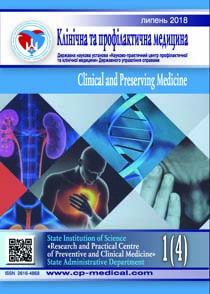Abstract
Objective. The predictive efficiency of the general clinical characteristics of acute coronary syndrome (ACS) patients and International score systems for the development of hemorrhagic complications (HC).
Materials and methods. Results of clinical, clinic-laboratory parameters of 93 patients with ACS, who had been treated at the State Institution of Science “Research and Practical Center of Preventive and Clinical Medicine” State Administrative Department (2016-2017 y.), were analyzed. The total predictive power (PP) was evaluated using ROC analysis with the area under the curve (AUC). Methods: general clinical, clinic-laboratory, statistical.
Results. Hemorrhagic complications were observed in 22.5 % (21 of 93) ACS patients. In order to assess the probability of HC during the ACS treatment we recommend to take into account the anemia presence (AUC = 0.79; 95 % CI = 0.69-0.86; p < 0.0001), the age over 75 years AUC = 0.76; 95 % CІ = 0.66-0.84; p = 0.0001), the use of triple antithrombotic therapy (TATT) (AUC = 0.87; 95 % CІ = 0.73-0.93; p < 0.0001). Between the score systems, which were analyzed, the highest PP was observed in REPLACE (AUC = 0.88; 95 % CІ = 0.80-0.94; р < 0.0001) and ACUITY (AUC = 0.83; 95 % ДІ = 0.74-0.90; р < 0.0001), which have “very good” predictive efficiency. Instead, the level of efficiency CRUSADE (AUC = 0.78; 95 % CІ = 0.65-0.88; р = 0.0003) and RISK-PCI (AUC = 0.73; 95 % CІ = 0.57-0.86; р = 0.0023) is «good».
Conclusion. It is recommend to take into account the anemia presence, the age over 75 years, TATT for the purpose of the prognosis of HC in ACS. The highest PP was observed in REPLACE and ACUITY that have “very good” predictive efficiency.
References
2. Moscucci M., Fox K. A., Cannon C. P. (2003). Predictors of major bleeding in acute coronary syndromes: the Global Registry of Acute Coronary Events (GRACE). Eur. Heart. J., 24 (20), 1815–1823.
3. The Platelet Receptor Inhibition in Ischemic Syndrome Management (PRISM) Study Investigators. A comparison of aspirin plus tirofiban with aspirin plus heparin for unstable angina. (1998). N. Engl. J. Med., 338 (21), 1498–1505.
4. Stone G.W., McLaurin B.T., Cox D.A. (2006). ACUITY Investigators. Bivalirudin for patients with acute coronary syndromes. N. Engl. J. Med., 355 (21), 2203-2216.
5. Subherwal S., Bach R.G., Chen A.Y. (2009). Baseline risk of major bleeding in non-ST segment elevation myocardial infarction: the CRUSADE (Can Rapid risk stratification of Unstable angina patients Suppress ADverse outcomes with Early implementation of the ACC/AHA guidelines) bleeding score. Circulation., 119 (114), 1873–1882.
6. Mathews R., Peterson E.D., Chen A.Y. (2011). In-hospital major bleeding during ST-elevation and non-ST-elevation myocardial infarction care: derivation and validation of a model from the ACTION Registry(R)-GWTG. Am. J. Cardiol., 107, 1136-1143.
7. Mehran R., Pocock S.J., Nikolsky E. (2010). A risk score to predict bleeding in patients with acute coronary syndromes. J. Am. Coll. Cardiol., 55, 2556-2566.
8. Montalescot G, Salette G, Steg G. (2011). Development and validation of a bleeding risk model for patients undergoing elective percutaneous coronary intervention. Int J Cardiol., 15, 79-83.
9. Mrdovic I., Savic L., Krljanac G. (2013). Simple risk algorithm to predict serious bleeding in patients with ST-segment elevation myocardial infarction undergoing primary percutaneous coronary intervention: RISK-PCI bleeding score. Circ. J., 77, 1719-1727.
10. Nikolsky E., Mehran R., Dangas G. (2007). Development and validation of a prognostic risk score for major bleeding in patients undergoing percutaneous coronary intervention via the femoral approach. Eur. Heart. J., 28, 1936-1945.
11. Rao S.V., McCoy L.A., Spertus J.A. (2013). An updated bleeding model to predict the risk of post-procedure bleeding among patients undergoing percutaneous coronary intervention: a report using an expanded bleeding definition from the National Cardiovascular Data Registry CathPCI Registry. JACC Cardiovasc. Interv., 6, 897-904.
12. Subherwal S., Bach R.G., Chen A.Y. (2009). Baseline risk of major bleeding in non-ST-segment-elevation myocardial infarction: the CRUSADE (Can Rapid risk stratification of Unstable angina patients Suppress ADverse outcomes with Early implementation of the ACC/AHA Guidelines). Bleeding Score. Circulation, 119, 1873-1882.
13. Hamm C.W., Bassand J.P., Agewall S. (2011). ESC Guidelines for the management of acute coronary syndromes in patients presenting without persistent ST-segment elevation: The Task Force for the management of acute coronary syndromes (ACS) in patients presenting without persistent ST-segment elevation of the European Society of Cardiology (ESC). Eur Heart J., 32, 2999-3054.
14. de Andrade P. B., Tebet M. A., Maia da Silva F. S. (2011). Major Bleeding in Acute Coronary Syndromes J. Invasive Cardiol., 23 (11), 485–490.

This work is licensed under a Creative Commons Attribution-NonCommercial 4.0 International License.

